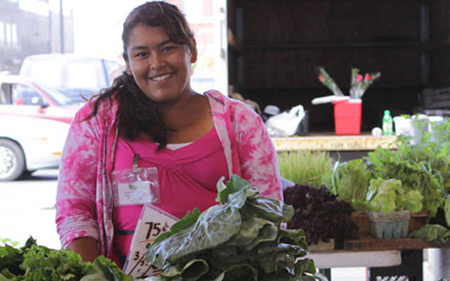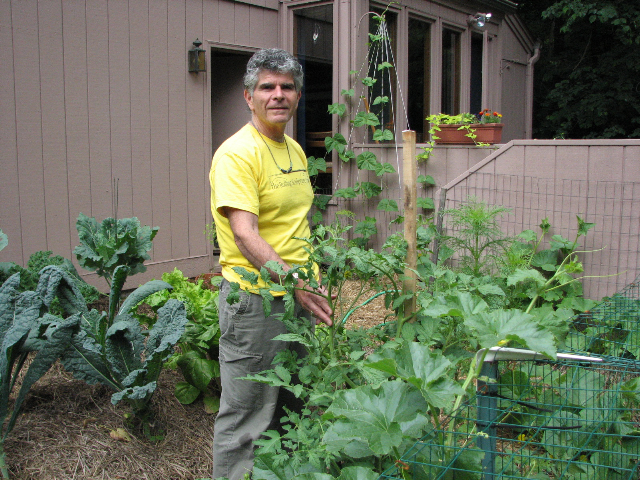MAKE TWICE THE IMPACT
Help us support healthier families, stronger local economies, and a more resilient food system for us all.
Your gift today will be matched thanks to the Hamp Family Fund.
April 19, 2012
Author: Ian Beck
Recently, we had the opportunity to interview friend, visionary and founder of the Fair Food Network, Oran Hesterman PhD, who took time to share his inspirations, hopes for the future, recent work and a few of his favorite sustainable meals with us. It’s the perfect side dish to go along with The Sustainable Food Challenge!
The Collective (TC): What was your moment of obligation? Who/what inspired you to get involved in food justice issues?
Oran Hesterman (OH): Growing up in Berkeley, CA in the 1960’s gave me a very interesting early perspective on the possibility for change and transformation that has been a foundation for me all my life. I spent my early college years at UC Santa Cruz where I worked with the renowned visionary, Allan Chadwick, one of the first people to bring biodynamic farming practices to the U.S. Together with Chadwick and a cohort of devoted students, I helped to plant extensive gardens and orchards on the UC campus that has evolved into the Center for Agro- Ecology and Sustainable Food Systems that today sponsors one of the most sophisticated agricultural apprenticeship programs in the country.
This experience helped me come to an early understanding that my purpose in life was to protect the Earth that nurtures us and to ensure that future generations can have access to fresh, healthy and sustainably grown food.
TC: What is your vision of “Fair Food”? What does it mean for our society? For our economy? For our environment?
OH: I founded Fair Food Network (FFN) to guarantee access to healthy, fresh and sustainably grown food, especially in underserved communities. We work at the intersection of food systems, sustainability and social equity where our society, economy, and environment are all at stake.
What does this mean? A “Fair Food” system should provide healthy, nutritious, and safe food for everyone, grown in a manner that stewards the natural environment. Based on a more equitable distribution of resources, it should respect the wisdom of natural systems and produce a variety of crops and livestock, all grown in a manner that recycles the waste from one part of the system for use in another. This food system would actually reduce the production of greenhouse gases that threaten untenable warming of our planet. At the same time, it would buffer us against the effects of climate changes that we know are coming. And, perhaps most important, this food system should recognize the strength of ethnic, racial, and cultural diversity and challenge the structural racism and classism that for so long have determined who has access to healthy food.

Vendor at a Double Up Food Bucks participating market.
FFN is also laying the groundwork for achieving real change in American food policy for the 47 million Americans on food stamps. Our successful Double Up Food Bucks (DUFB) demonstration project, based in Michigan and involving tens of thousands of people, has demonstrated that monetary incentives simultaneously encourage healthier food choices for low-income families and strengthen the local economy. Supporting local and regional food systems in this manner promotes self sufficiency and sustainability at both individual and communal levels, providing benefits at both the producer and consumer ends.
TC: What is the greatest challenge/barrier to a sustainable food system today?
OH: I have found myself in conversations with people whose view is along the lines of “I can walk into any number of supermarkets in my city and buy whatever I want pretty much any time. And from spring through fall, I can go to the weekly farmers’ market and purchase great local food directly from the farmer. I don’t see any problem with our food system at all.” To those friends, I usually say, “If you live in the right place and have enough money, it can appear that the food system is functioning just fine. Just like the health care system seems to function for those of us who have decent insurance and access to competent medical care.” But if you take a closer look at our food system, the picture isn’t as rosy.
The first step in addressing this systemic challenge is acknowledging the ways this affects us all. The challenges of our failing food system—whether related to the environment, diet and health, or social inequities—are real, and to fix them will take a redesign of the system, not a series of isolated fixes or individual measures.
TC: What are the greatest reasons for hope for a sustainable food system? What’s the key to change?
OH: A key to change is not only about what we put in our individual refrigerators and on our own plates, but changing how our food is grown, packaged, delivered, marketed and sold. I hope to help move individuals from being conscious consumers to engaged citizens, ensuring that healthy, sustainably-raised food is accessible and affordable to everyone.
I see this key to change embodied in a set of “principles” which are essential to include in a redesigned food system. A fair food system needs to retain certain positive features of our current system, such as efficiency, high crop yields, and convenience, and balance them with some new principles. The four principles I think most crucial to a functional, sustainable, redesigned food system are equity, diversity, ecological integrity, and economic viability for all participants in the food supply chain.
TC: What’s your favorite all time “fair food” story? What does it teach all of us about what’s important and what we can do?
OH: A favorite “fair food” story deals with the Campaign for Fair Food that since 2001 has been working on behalf of the two to three million migrant field workers in the US, starting with the tomato workers in Immokalee, Florida. Led by Lucas Benitez and the Coalition of Immokalee Workers (CIW), courageous farm workers are teaming up with students and others to build more equity into our food system, one penny at a time. Rather than struggling to achieve agreements with growers, the Campaign is working to get concessions from the part of the system that actually has some flexibility: the retail sector. By working with top executive at some of the companies that purchase tomatoes from the Florida growers, historic agreements are being reached.
The Coalition of Immokalee Workers banded together with student activist groups on college campuses across the country and threatened boycotts of food outlets that did not negotiate with CIW for fairer wages and conditions; these students were able to help bring about change. In October 2010, Pacific Tomato Growers pledged to improve its working conditions and pay harvesters a penny more per pound, which could raise annual wages dramatically.
This example shows us that we need to understand the whole food system in order to know how to transform it effectively. Because the workers created an alliance with the students to bring pressure on the retail market, change could take place back down in the fields. It may be small at the moment, but the model being created with tomato growers and workers could be replicated with other crops and by other organizations to become a blueprint for farm worker justice.
TC: What’s the link between rural and urban communities in creating a more sustainable food system?
OH: This link is a vital one and is tied to the Farm Bill. Many have viewed the Farm Bill as a piece of rural legislation. With more than two-thirds of USDA Farm Bill funding directed to nutrition assistance and the vast majority of SNAP clients living in urban areas, the bill is already the most important federal urban food systems policy. It is in the long-term interests of both urban and rural stakeholders to find a way for the Farm Bill to create cooperative urban–rural links. Having Congress give the USDA broader authority to fund urban food systems programs would be a step in the right direction.
Additionally, the demand for locally and regionally produced food is growing rapidly, but farmers and ranchers need better ways to get their healthy food to markets. Credit and entrepreneurial training to build regional aggregation, processing and transportation networks would enable producers to meet the new market demand efficiently. Investing in this type of regional infrastructure will link urban consumers with rural producers and create new job opportunities in both communities.
TC: What’s your favorite sustainable meal? Can you tell us a story? Paint a picture of what’s on your plate and why?
OH: Without question, I have a favorite sustainable meal that takes me from the greens and potatoes harvested right outside my kitchen door, in my bountiful garden in Ann Arbor, MI, to the reef-net wild-caught salmon from the Pacific Ocean. In 2003, I initiated a buying club to purchase this amazing salmon from our partner fishermen on Lummi Island in Northern Washington state where I first tasted this outstanding fish. Twice a year, over 1000 pounds of salmon, black cod, and scallops are trucked into Ann Arbor from our fisherman in the Pacific Northwest directly to a loading dock where a representative from each one of our buying club families comes to pick up boxes of fish. We pay only 50 to 60 percent of what it would cost to purchase wild-caught salmon from a local retailer, including shipping. And the fishermen at Lummi Island get three times the wholesale price for their product. We were the first buying club to connect with Lummi Island Wild, but now they have several buying clubs, of which Ann Arbor is one of the largest.
And the dessert of my favorite meal is a fresh peach and blueberry crisp with the fruit picked that day by our local farmers and purchased at our local farmers’ market. Even in the deepest of winter, I just pull the fresh frozen fruit out of the freezer and taste the juicy, sweet, freshness of mid summer Michigan.

Oran in his garden.
TC: Anything else you’d like to share with The Collective members about sustainable food? What really matters? How they can get involved?
OH: We at FFN continue to implement and gather data about innovative projects and replicable models that grow a fairer food system – all this with an eye to having an effect on the Farm Bill discussions that will be taking place this year. On the individual level, I’d like to reiterate the need in a shift from conscious consumers to engaged citizens. The final chapter of Fair Food is a list of fair food “solutionaries” beyond those mentioned throughout the book. If Collective members want to get involved, have a look at the Fair Food List – a sort of Craig’s list of the sustainable food systems world. We encourage organizations already involved in the fair food movement to submit an entry. Regardless of where you fall on the spectrum between conscious consumer and engaged citizen, there will be at least one organization on the list that can use your time, talent, and resources to grow the good!
Originally posted on jointhecollective.net. Join the conversation about the future of Sustainable Food in The Collective.